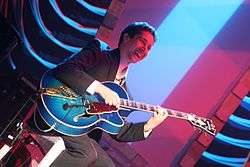John D'Angelico
John D’Angelico (1905–1964) was a luthier from New York City, noted for his handmade archtop guitars and mandolins.
Luthiery
John D’Angelico was born in 1905 in New York to an Italian-American family, and was apprenticed in 1914 to his great-uncle, Raphael Ciani, who made violins, mandolins, and flat top guitars.[1][2] D'Angelico took over as supervisor of Ciani’s shop when he died. In 1932, he began working on his own designs in his own workshop in New York.
Instrument designs and output
By 1937, D’Angelico had settled on at least four main f-hole archtop guitar designs, heavily influenced by the Gibson L-5:[3][4]
%2C_Chet_Atkins%2C_CMHF.jpg)
- Style A – 17 inch body. Phased out in the 1940s.
- Style B – 17 inch body. Phased out in the 1940s.
- Excel – 17 inch body
- New Yorker – 18 inch body. Approximately 300 made.[5]
Through at least the late 1930s, D’Angelico’s guitar necks had non-adjustable steel reinforcement. Later models had functional truss rods.[6] By the late 40s, D'Angelico was building only the Excel and the New Yorker. All New Yorker models featured pearl inlays in the headstock and fingerboards, as well as quadruple bindings.[7]
All of D’Angelico’s guitars were hand-built, and many were customized for specific people, so substantial variation is evident in his output. D’Angelico’s shop rarely made more than 30 guitars per year.[8] In all, it is estimated that he built 1,164 guitars.[9] D’Angelico also built a few round-hole (as opposed to f-hole) archtops, and a few mandolins.
During the 1950s, some of the instruments leaving D'Angelico's shop had mixed features, such as an Excel-sized guitar with New Yorker features created for Johnny Smith, or D'Angelico necks custom fitted to bodies customers brought in.[10] Original D'Angelico guitars are identified by a serial number punched inside the bass f-hole—the serial numbers ranging from 1001 to 2164.[10]
D’Angelico suffered a series of heart attacks starting in 1959, and also suffered from pneumonia. He died at age 59 in 1964. The D'Angelico Guitars brand has continued under other owners.
Employees
Some of D'Angelico's employees went on to become craftsmen in their own right. Among them were Jimmy Di Serio, who worked for D'Angelico from 1932-1959, and Jimmy D'Aquisto, who worked for D'Angelico in the last few years of his life.
In 1952, he hired D'Aquisto as an apprentice, who would eventually buy the business from the D'Angelico family. D'Angelico and D'Aquisto are generally regarded as the two greatest archtop guitar makers of the 20th century.[11]
In 2011, works by D'Angelico and D'Aquisto were included in the 'Guitar Heroes' exhibition at the Metropolitan Museum of Art in New York City.[12]
Vincent "Jimmy" DiSerio, was commissioned by Ralph Patt to modify a Gibson ES-150 (six-string archtop hollow-body guitar) to have a wider neck, wider pickup, and eight strings circa 1965; seven strings enabled Patt's major-thirds tuning to have the E-E range of standard tuning, while the eighth string enabled the high A♭.[13]
Musicians playing D'Angelico guitars
See also
References
- ↑ Bonds, Ray (ed.) (2006). “The illustrated directory of guitars.” Barnes & Noble/Salamander Books, p. 104.
- ↑ Wheeler, Tom (1982). American guitars: an illustrated history.” Harper & Row. p. 22.
- ↑ Bonds, Ray (ed.) (2006). p. 104.
- ↑ Achard, Ken (1999). "The History and Development of the American Guitar." The Bold Strummer, p. 16.
- ↑ Denyer, Ralph (1998). “The guitar handbook.” Alfred A. Knopf. p. 47.
- ↑ Wheeler, Tom (1982). pp. 22-23.
- ↑ Achard, Ken (1999). p. 16.
- ↑ Bonds, Ray (ed.) (2006). p. 106.
- ↑ Wheeler, Tom (1982). pp. 22.
- 1 2 Achard, Ken (1999). p. 43.
- ↑ "Images from the Lillibridge Gallery". D'Angelico/D'Aquisto/Gudelsky Workshop. National Music Museum; The University of South Dakota 414 East Clark Street Vermillion, SD 57069. September 8, 2009. Retrieved December 4, 2012.
- ↑ "Guitar heroes: Legendary craftsmen from Italy to New York, February 9-July 4, 2011". John D'Angelico. The Metropolitan Museum of Art, New York:. Retrieved December 4, 2012.
- ↑ Peterson (2002, p. 37)
Notes
- Peterson, Jonathon (2002). "Tuning in thirds: A new approach to playing leads to a new kind of guitar". American Lutherie: The Quarterly Journal of the Guild of American Luthiers. 8222 South Park Avenue, Tacoma WA 98408: USA.: The Guild of American Luthiers. Number 72 (Winter): 36–43. ISSN 1041-7176. Retrieved 9 October 2012.


